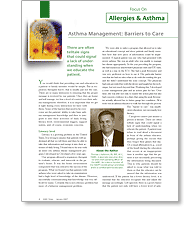 |
|||||
|
|
Spring 2007 New Guidelines Will Help You Breathe Easy Pharmacology and Delivery Devices: What Works Best for Your Patient? Asthma Management: Barriers to Care
|
|
|
By Thomas J. Kallstrom Often respiratory therapists find that their asthma patients don't comply with their asthma management program. In this article in AARC Times, the respiratory therapist's professional publication, learn how therapists are recognizing and tackling barriers to care for asthma patients. You would think that providing care and education to a patient or family member would be simple. But as respiratory therapists know, that is usually just not the case. There are so many intricacies to ensuring that the proper message is received by our patients. Once they go home and self manage, we lose a level of control over their asthma management; therefore, it is so important that we get it right during every interaction we have with them. Some of the barriers that need to be overcome are the patients’ ability to take basic asthma management knowledge and then to integrate it into their activities of daily living, literacy level, environmental triggers, support system, and, of course, economic concerns. Literacy level Our program allowed a respiratory therapist to evaluate, educate, and intercede in the patient’s home. It was the home environment component that was critical to the success of the program. What we found was that patients with asthma who were asked to take an examination had a high level of knowledge of the disease. However, successfully communicating that knowledge was very difficult for many. Certainly this is not a literacy problem but more of a behavior management problem. We were able to tailor a program that allowed us to take an educational concept and show patients and family members how that new piece of information could be implemented. A typical patient was one who had presented with severe asthma. She was an adult who was unable to manage her disease appropriately. In the year preceding the program, she had numerous unscheduled physician visits and ER visits, as well as a stay in the ICU. She had a peak flowmeter and was very proficient on how to use it. Her particular barrier was that she had no idea what to do with the reading she got, and she didn’t understand the zone concept. Her physician had only provided her with the device and taught her the technique, but not much beyond that. Realizing this, I developed a zone management plan and an action plan for her. Over time, she was able not only to master the action plan but also had concrete evidence in a diary that using the peak flowmeter actually allowed her to better gauge her condition. All it took was an asthma educator to walk her through the process. Her “barrier to care” was insufficient education, not necessarily low literacy. Caregivers cannot just assume a person is literate. There are often telltale signs that could signal a lack of understanding when we educate the patient. A patient may refuse to read aloud a document in front of the asthma educator, perhaps giving the excuse that they forgot their glasses that day. Or a visual affirmation (e.g., a nod of the head) during the education that occurs at an inappropriate time is another sign that the patient is not necessarily perceiving the information being discussed. This is why patients should be asked to recap what was told to them so that the educator can be assured that the information was understood. If the patient has a lower literacy level, it is essential that the educator recognize this and adjust the message accordingly. Left ignored, there is a good chance that the patient not only will have a lower level of satisfaction of their care but also will be less likely to actually participate in the decisions of their ongoing care.1 Environmental triggers Support system Economic concerns References Available resources About the author |
|

